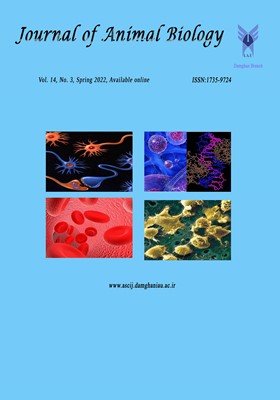بررسی اثر دوز پایین مت آمفتامین بر سیکل سلولی در سلولهای آستروسیت انسانی تیمار شده با آمیلویید بتا
الموضوعات : فصلنامه زیست شناسی جانوری
بیتا سلطانیان
1
,
مرضیه دهقان شاسلطنه
2
![]() ,
غلامحسین ریاضی
3
,
ناهید مسعودیان
4
,
غلامحسین ریاضی
3
,
ناهید مسعودیان
4
1 - گروه زیستشناسی، واحد دامغان، دانشگاه آزاد اسلامی، دامغان، ایران
2 - گروه زیست شناسی، دانشکده علوم دانشگاه زنجان، زنجان، ایران
3 - مرکز تحقیقات بیوشیمی و بیوفیزیک (IBB)، دانشگاه تهران، تهران، ایران
4 - گروه زیستشناسی، واحد دامغان، دانشگاه آزاد اسلامی، دامغان، ایران
الکلمات المفتاحية: مت آمفتامین, آستروسیت, سیکل سلولی, سیکلین کیناز1, سیکلین E2,
ملخص المقالة :
آستروسیتها فراوانترین و مهمترین سلولهای کمک کننده به نورونها هستند، در بقا سلولهای عصبی و در هموستاز یونی و اسمزی و همچنین در شکل گیری سیناپس و کمک به رشد آکسونها و دندریتها نقش دارند، در بیماری آلزایمر مارکرهای فعالکننده سیکل سلولی افزایش مییابد. از مارکرهای سیکل سلولی Cdk1 و CE2 میباشد. با توجه به اینکه مت آمفتامین در دوزهای غیرسمی باعث کاهش ظرفیت تقسیم خودبهخودی و هدایت سلول به سمت تمایز میشود در این مطالعه، سیکل سلولی و مارکرهای آن در سلولهای آستروسیت انسانی تیمار شده با آمیلویید بتا و با دوز پایین مت آمفتامین درمان شدند مورد مطالعه قرار داده و میزان بیان ژنهای cdk1 وCE2 و سیکل سلولی میزان توقف در G1، G2 و S در گروههای مختلف مورد بررسی قرار گرفت. 5 گروه مختلف جهت بررسی مورد استفاده قرار گرفت 1-سلولهای مجاور با آمیلوئید بتا 2- سلولهای مجاور با مت آمفتامین، 3- سلولهای مجاور با آمیلوئید و سپس مت آمفتامین، 4- سلولهای مجاور با مت آمفتامین سپس با آمیلوئید بتا 5 – گروه کنترل، هر گروه 3 بار تکرار شد. میزان بیان cdk1 در گروه 3 یا گروه درمان کاهش داشته ولی در گروه 4 یا پیشگیری افزایش داشته و میزان بیان CE2 در هر 2 گروه کاهش داشته و همچنین میزان توقف سلول در G1، G2 و S بررسی شد که میزان توقف در G1 در گروه 3 یا گروه درمان کاهش داشته ولی در گروه 4 یا پیشگیری افزایش داشته است. نتیجه با توجه به این که از اولین علایم آلزایمر تغییرات در سیکل سلولی میباشد. دوز پایین مت آمفتامین میتواند بر مارکرهای فعالکننده سیکل سلول اثر کاهشی داشته و همچنین تقسیم سلول و رفتن به سمت مرگ سلولی را کاهش دهد.
_||_


